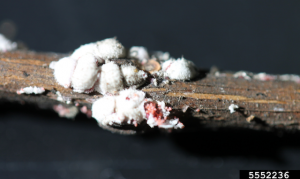
Efforts by horticultural breeders have resulted in the release of dozens of crape myrtle cultivars over the years. In fact, they are one of the most widely utilized woody ornamentals throughout Florida, with a wholesale value estimated at $66 million. Offering a broad range of floral colors, bark patterns, and forms, crape myrtle also exhibits improve disease resistance and is extremely heat and drought tolerant.
Historically, crape myrtle has been susceptible to a very limited range of pests and pathogens, which generally include powdery mildew (Erysiphe lagerstroemiae) and the crape myrtle aphid (Tinocallis kahawaluokalani). However, scientists at the University of Florida have recently reported the presence of crape myrtle bark scale (Acanthococcus lagerstroemiae) from a residential landscape in Santa Rosa County.

Native to Asia, it was initially discovered in areas of Texas in 2014 and has subsequently spread through ornamental trade to areas of North Carolina, Virginia, Alabama, and Georgia. This scale insect primarily causes damage in its immature, nymphal stage through the production of honey dew which acts as an ideal substrate for fungal pathogens like black sooty mold.

Adults are white and gray in color and up to 2 mm in length, while the immature crawlers and egg masses are pink. When crushed, a pink colored liquid is excreted.
For more information on the crape mrytle bark scale, be sure to check out this EDIS article.
If you suspect that you may have crape myrtle bark scale in your landscape, please contact your local county extension agent.
If residing in the Florida panhandle area, you may also directly contact Dr. Xavier Martini (xmartini@ufl.edu), or Dr. Adam Dale (agdale@ufl.edu) if in central or south Florida.
 0
0
